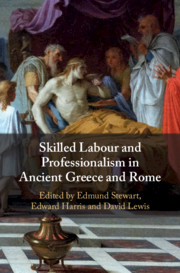Book contents
- Skilled Labour and Professionalism in Ancient Greece and Rome
- Skilled Labour and Professionalism in Ancient Greece and Rome
- Copyright page
- Contents
- Illustrations
- Contributors
- Acknowledgements
- Abbreviations
- Introduction
- Part I Professionals and Professional Identity in Greece and Rome
- Part II Specialization and the Division of Labour in the Ancient City
- 4 Labour Specialization in the Athenian Economy: Occupational Hazards
- 5 The Perception of ‘Skills’ in Ostia: The Evidence of Monuments and Written Sources
- Part III Case Studies of Professions 1: Sculpture
- Part IV Case Studies of Professions 2: Music and Athletics
- Part V Case Studies of Professions 3: A Profession of Arms?
- Index
- References
4 - Labour Specialization in the Athenian Economy: Occupational Hazards
from Part II - Specialization and the Division of Labour in the Ancient City
Published online by Cambridge University Press: 18 September 2020
- Skilled Labour and Professionalism in Ancient Greece and Rome
- Skilled Labour and Professionalism in Ancient Greece and Rome
- Copyright page
- Contents
- Illustrations
- Contributors
- Acknowledgements
- Abbreviations
- Introduction
- Part I Professionals and Professional Identity in Greece and Rome
- Part II Specialization and the Division of Labour in the Ancient City
- 4 Labour Specialization in the Athenian Economy: Occupational Hazards
- 5 The Perception of ‘Skills’ in Ostia: The Evidence of Monuments and Written Sources
- Part III Case Studies of Professions 1: Sculpture
- Part IV Case Studies of Professions 2: Music and Athletics
- Part V Case Studies of Professions 3: A Profession of Arms?
- Index
- References
Summary
This chapter aims to establish a lower limit to the possible extent of horizontal specialization in the economy of classical Athens; in other words, the minimum plausible number of specialized jobs to do with production, exchange, and services. This exercise shows that even with a mindset sceptical to the idea of specialization, there cannot realistically have been fewer than 162 specialized full-time occupations in classical Attica. This demonstrates the complexity and dynamism of the classical Athenian economy.
- Type
- Chapter
- Information
- Skilled Labour and Professionalism in Ancient Greece and Rome , pp. 129 - 174Publisher: Cambridge University PressPrint publication year: 2020
References
- 4
- Cited by

